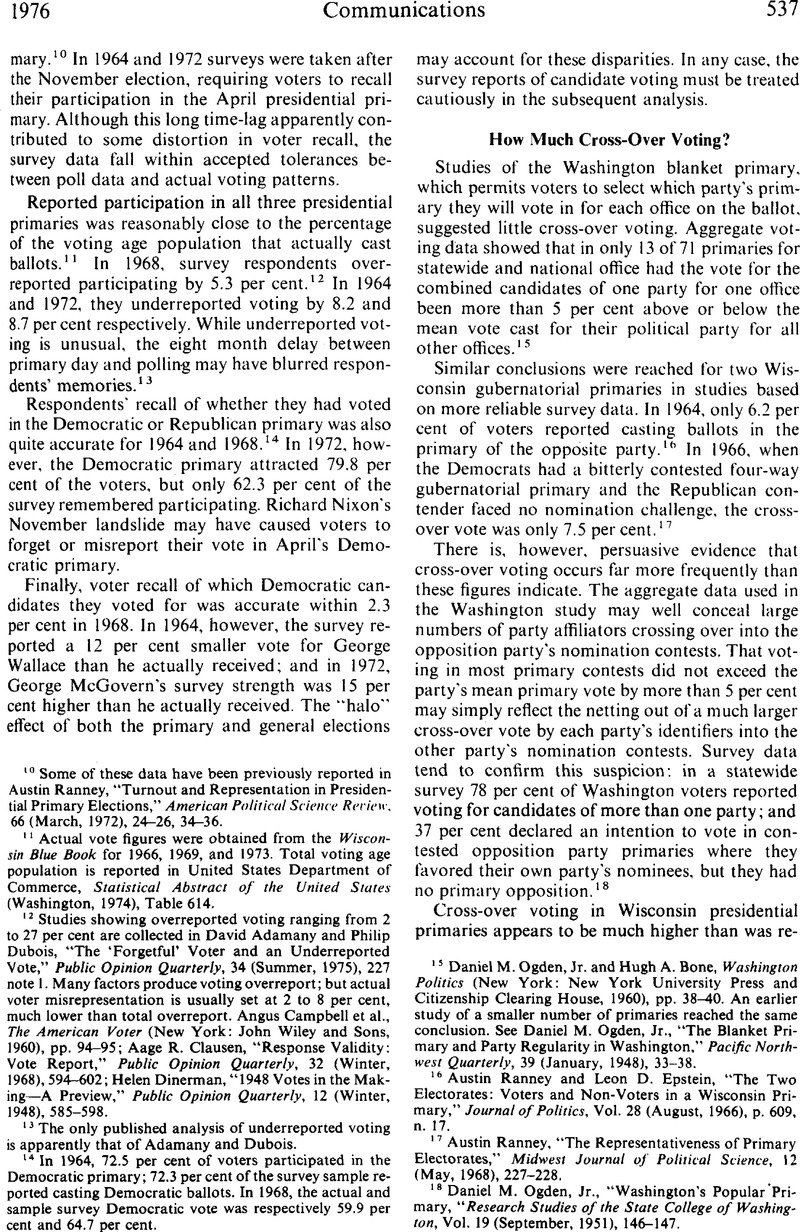No CrossRef data available.
Article contents
How Much Cross-Over Voting?
Published online by Cambridge University Press: 01 August 2014
Abstract

- Type
- Communications
- Information
- Copyright
- Copyright © American Political Science Association 1976
References
15 Ogden, Daniel M. Jr. and Bone, Hugh A., Washington Politics (New York: New York University Press and Citizenship Clearing House, 1960), pp. 38–40Google Scholar. An earlier study of a smaller number of primaries reached the same conclusion. See Ogden, Daniel M. Jr., “The Blanket Primary and Party Regularity in Washington,” Pacific Northwest Quarterly, 39 (January, 1948), 33–38Google Scholar.
16 Ranney, Austin and Epstein, Leon D., “The Two Electorates: Voters and Non-Voters in a Wisconsin Primary,” Journal of Politics, Vol. 28 (August, 1966), p. 609, n. 17CrossRefGoogle Scholar.
17 Ranney, Austin, “The Representativeness of Primary Electorates,” Midwest Journal of Political Science, 12 (May, 1968), 227–228CrossRefGoogle Scholar.
18 Ogden, Daniel M. Jr., “Washington's Popular Primary, “Research Studies of the State College of Washington, Vol. 19 (September, 1951), 146–147Google Scholar.
19 In one-party situations, the weaker party may have very few primary contests and its partisans may therefore cross over into the dominant party's primary without for going choices within their own party. This may explain the apparently high cross-over vote in earlier Wisconsin gubernatorial primaries. See Epstein, Leon D., Politics in Wisconsin (Madison: University of Wisconsin Press, 1958), pp. 35–40, 95–96Google Scholar. Also Sorauf, Frank J., Party Politics in America, 2nd ed. (Boston: Little, Brown and Co., 1972), p. 214Google Scholar.
20 Survey respondents were divided by the standard seven-point scale. Independent Republicans and independent Democrats were classified as party affiliators, because it is probable that under the mildest form of party registration, in which the partisan declares his affiliation at the polls, they would be willing to volunteer a party identification in order to vote. Participating in the opposition party primary would, therefore, be cross-over voting for them.
21 A survey of 382 voters as they left the polling places in 1972 set the composition of the Democratic primary at 73.3 per cent Democrats, 19.3 per cent Republicans, and 7.3 per cent independents. The poll, commissioned by The New York Times and conducted by Yankelovich, Skelly, and White, Inc., was made available by the Wisconsin Legislative Reference Library. We attribute the difference between the one-third in our survey who reported crossing over and the one-quarter in the Yankelovich survey to the less reliable sampling technique used by the latter.



Comments
No Comments have been published for this article.